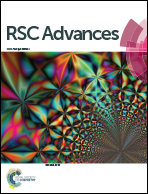Y-shaped block copolymer (methoxy-poly(ethylene glycol))2-b-poly(l-glutamic acid): preparation, self-assembly, and use as drug carriers
Abstract
Y-shaped amphiphilic block copolymers, (methoxy-poly(ethylene glycol))2-block-poly(L-glutamic acid) ((mPEG)2-PGA) and its precursor (methoxy-poly(ethylene glycol)2-block-poly(γ-benzyl-L-glutamate) ((mPEG)2-PBG), were prepared in three steps: (1) macroinitiator (methoxy-poly(ethylene glycol))2-NH2 ((mPEG)2-NH2) was synthesized by coupling two methoxy-poly(ethylene glycol)s with serinol and diisocyanate. (2) (mPEG)2-PBG was synthesized by ring opening polymerization of γ-benzyl-L-glutamate-N-carboxyanhydride initiated with the macroinitiator ((mPEG)2-NH2); (3) the protective benzyl groups in (mPEG)2-PBG were removed to obtain (mPEG)2-PGA. The properties of both (mPEG)2-PBG and (mPEG)2-PGA were characterized by 1H NMR, FT-IR, GPC, and DLS. In aqueous solution (mPEG)2-PBG tends to form more stable micelles compared to linear mPEG-PBG copolymer. The size of (mPEG)2-PBG decreases with increasing length of hydrophobic PBG in (mPEG)2-PBG. Paclitaxel and cisplatin were grafted onto (mPEG)2-PGA to form (mPEG)2-PGA-PTX (MPTX) with a grafting ratio of near 90% and (mPEG)2-PGA-Pt (MPt) conjugates with a loading efficacy of 15% (w/w). MPTX can greatly improve the solubility of PTX. Both conjugates can self-assemble into micelles with a mean diameter of about 50 nm and show enhanced anti-cancer activity against MCF-7, HeLa, and SMMC cell lines. The in vivo anticancer evaluation in mice shows MPt showed a desirable antitumor activity and allowed us to deduce the system toxicity. Therefore, both MPTX and MPt have a great potential as a polymer drug in cancer chemotherapy.


 Please wait while we load your content...
Please wait while we load your content...